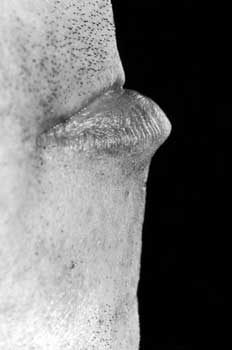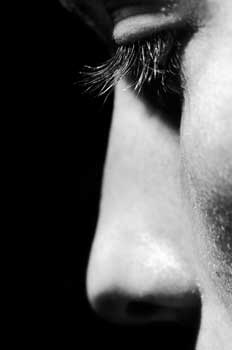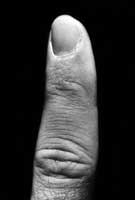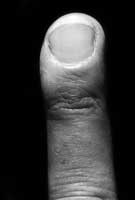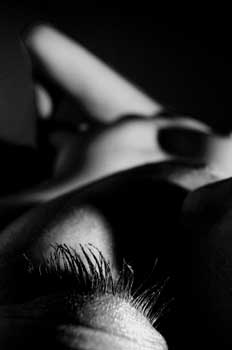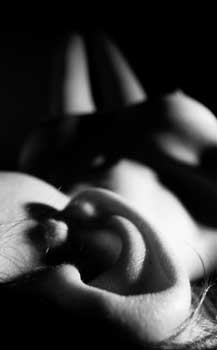The end of the 1990s marked a new stage in the history of Polish photography and greatly quickened photographic debuts. The most positive aspect of this fact is that very young, twenty-year-old artists have an opportunity to present their works in the most prestigious galleries in the country. Graduates and students of artistic schools and colleges take part in numerous exhibitions. In fact, academic institutions where photography is taught begin to compete among themselves - people even talk about their individual features or at least try to define them.
Dominik Pabis is a student at the Department of Photography of the Academy of Fine Arts in Gdańsk (extra-mural licence studies). He is surely one of the most outstanding students there. He has begun his artistic career with a few series of photographs that have one thing in common: they analyze and explore without pointing to the metaphysics of the object, although its metaphysical aspect is sometimes revealed later. Pabis's artistic personality is still in the making, which is quite understandable, taking his young age into account.
I.
The first group of his works in an original way relates to the problem of the portrait, but seen not from the point of view of an orthodox interpretation of the term. We have to do here with a perverse trick which does not disregard the documentary qualities of the photographic medium. The photograph of fingers set against a black background makes us realize that they have their individual appearance. The artist searches for portrait features in such photographs, as far as it is possible in works of this type, of course. Skilful lighting of the fingers stresses their vividnes and creates new qualities. Pabis gives the fingers a monumental look and seems to suggest that the photograph was taken in the studio against a black background. Moreover, he is convinced that in a certain way, difficult to understand, they may be to a certain degree a spiritual portrait of the whole individual to whom the fingers belong and whom they characterize. It is difficult to judge convincingly to what extent our fingers are the reflection of our "phisis". But Pabis's works have the virtue of being nagging, detailed analyses, carried out by means of the photographic medium. He is also wondering how to present his works formally, whether to show them en globe or perhaps as large formats? Additionally, the photographs bear captions at the bottom, which might give us clues as to the identity of the individuals presented, though not necessarily - because only the initials of their first and last names are given. There may be other solutions to this problem, too. Pabis succeeded in developing this series in interesting directions, which is positively commendable and proves that he has talent.
|
II.
Pabis's next series has to do with a more concrete photographic problem, namely with the question of the focus of photographs, conceived as documentary realizations and showing fragments of the human body in its extraordinary aspects. This type of approach recalls the works of Zbigniew Dłubak from the 1940s and especially from the 80s and 90s (the "Asymetry" series). What is the difference between Dłubak's and Pabis's photographs? Between 1947 and 1948 Dłubak was interested in the surrealism of his tragic experience and memories of the Second World War. In a series called "Asymetry", which has a different painting-like quality, the artist shows relations internal to an image - things in focus and out of focus under which various intimate experiences are hidden. I believe that some of Pabis's photographs must be analyzed in the context of Dłubak's works. Nevertheless, the works of the young artist from Cracow possess also other aspects, like the gentle movement from in-focus details to the far fields out of focus. This problem is also present in contemporary visual culture which - for example in David Lynch's films - surprises the viewers by going suddenly from a detail to a location shot. Such shifts are usually accompanied by grotesque events. Let us take, for instance, the film "Blue Velvet", where in one of the first sequences we see a detail of a severed human ear, lying in the grass: when magnified, it becomes the entrance to the mysterious labirynth of the human life with its dark and hidden aspects. I happen to point to this motif from the famous film because one of Pabis's photographs presents a detail of an ear, while in the background we see a human body, fading into blackness. This does not mean that we should be looking for closer relations between Lynch's and Pabis's work, although I believe that as far as the way of filming and dynamic editing are concerned, Lynch's influence has become quite common, even if people often do not realize it. Lynch has become one of the most significant artists of the close of the 20th century. In Pabis's case we can sometimes additionally observe the movement from the figure of the body to a landscape. This is a very important aspect of his photographs, far from the works of Dłubak or from Lynch's pictures because it grasps within a single frame some very different sides of the visual world. In fact, for the time being it has become the fundamental feature of works by our interesting artist from Cracow. The group of photos in question begins with a "sharp frame" of a woman's face, but very different from Witkacy's or Jerzy Lewczyński's works from the fifties. This photograph is more peaceful and classic in its form and thus it definitely differs from Pabis's other photographs of more complicated visual structures. However, nowadays nobody expects complete consistency since it is unnecessary, not to say anachronistic.
III. A few photographs which show fragments of the human body draw our attention because their imagery is definitely more contrastive if not graphic. Such unusual form brings surprising results. At first sight we are not completely sure what we are seeing. The photos are mysterious and abstract in form, a form which is drawn directly from reality at hand - it may be a clean-shaven human head or a foot. We will find a distant echo of surrealistic explorations in this, but there is more to it. The surrealists attacked the imagination of their contemporaries on a very broad front. They used amateur pictures, abstract in character, set scenes or took to various manipulations with the negative and the positive. Enlarged fragments of the body and its reality are one of the most popular subjects in contemporary art and Pabis masterfully takes advantage of various possibilities of relating to it.
|
IV.
Pabis goes on to structure his works in yet another way, most ornamental of all - he prints pictures from a plotter which are a few metres long and abstract, although not really, since the picture's structure is based on an analogue photograph. Nowadays many photographers use computers to transform their works - the final result of such manipulations are print-outs. The artist makes the human body abstract and changes it into forms which strongly effect viewers. We are wondering which parts of the human body we are looking at. This kind of approach originated in surrealism when artists used the so-called mirror reflections, and later in pop-art, for example in the works of Roman Cieślewicz. Recently we have witnessed a further complication of the image which is often composed from four symmetrical counterparts. It is interesting that this kind of art springs up in different parts of the country, to mention just the works of Alicja Łukasik or Bogdan Kiwak. This surely means that abstract images have not lost their persuasive and, most of all, artistic qualities. But the origins of this type of art are different than in the case of minimal art or the constructivist tradition. It comes into being in the process of fragmentization of the human body. However, such works may be hazardous in that they may quickly become empty ornaments, devoid of any contents, not to mention ideas.
How should we evaluate Dominik Pabis's works? First of all, from the point of view of a debut because we judge the works of young artists in a different way than the works of those from whom we should demand much more. Which of his photographs are the most interesting? Before answering this question we must stress that all of Pabis's photographs are interconnected by means of a comprehensive and convincing analysis. As far as I am concerned, his most important works belong to the second group of photographs which I hypothetically distinguished. I will certainly follow the career of Dominik Pabis with great interest because it is just possible that he will further develop his artistic talents.
Krzysztof Jurecki
translation by Maciej Świerkocki
|

